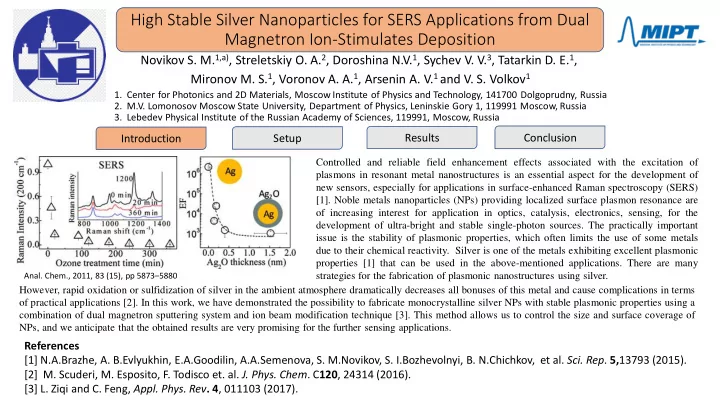

High Stable Silver Nanoparticles for SERS Applications from Dual Magnetron Ion-Stimulates Deposition Novikov S. M. 1,a) , Streletskiy O. A. 2 , Doroshina N.V. 1 , Sychev V. V. 3 , Tatarkin D. E. 1 , Mironov M. S. 1 , Voronov A. A. 1 , Arsenin A. V. 1 and V. S. Volkov 1 1. Center for Photonics and 2D Materials, Moscow Institute of Physics and Technology, 141700 Dolgoprudny, Russia 2. M.V. Lomonosov Moscow State University, Department of Physics, Leninskie Gory 1, 119991 Moscow, Russia 3. Lebedev Physical Institute of the Russian Academy of Sciences, 119991, Moscow, Russia Results Conclusion Introduction Setup Controlled and reliable field enhancement effects associated with the excitation of plasmons in resonant metal nanostructures is an essential aspect for the development of new sensors, especially for applications in surface-enhanced Raman spectroscopy (SERS) [1]. Noble metals nanoparticles (NPs) providing localized surface plasmon resonance are of increasing interest for application in optics, catalysis, electronics, sensing, for the development of ultra-bright and stable single-photon sources. The practically important issue is the stability of plasmonic properties, which often limits the use of some metals due to their chemical reactivity. Silver is one of the metals exhibiting excellent plasmonic properties [1] that can be used in the above-mentioned applications. There are many Anal. Chem., 2011, 83 (15), pp 5873 – 5880 strategies for the fabrication of plasmonic nanostructures using silver. However, rapid oxidation or sulfidization of silver in the ambient atmosphere dramatically decreases all bonuses of this metal and cause complications in terms of practical applications [2]. In this work, we have demonstrated the possibility to fabricate monocrystalline silver NPs with stable plasmonic properties using a combination of dual magnetron sputtering system and ion beam modification technique [3]. This method allows us to control the size and surface coverage of NPs, and we anticipate that the obtained results are very promising for the further sensing applications. References [1] N.A.Brazhe, A. B.Evlyukhin, E.A.Goodilin, A.A.Semenova, S. M.Novikov, S. I.Bozhevolnyi, B. N.Chichkov, et al. Sci. Rep . 5, 13793 (2015). [2] M. Scuderi, M. Esposito, F. Todisco et. al. J. Phys. Chem . C 120 , 24314 (2016). [3] L. Ziqi and C. Feng, Appl. Phys. Rev . 4 , 011103 (2017).
High Stable Silver Nanoparticles for SERS Applications from Dual Magnetron Ion-Stimulates Deposition Novikov S. M. 1,a) , Streletskiy O. A. 2 , Doroshina N.V. 1 , Sychev V. V. 3 , Tatarkin D. E. 1 , Mironov M. S. 1 , Voronov A. A. 1 , Arsenin A. V. 1 and V. S. Volkov 1 Introduction Results Conclusion Setup Experimental realization of the combination of dual magnetron sputtering system and ion beam modification technique Formation of NPs Ag film Ag film after argon-ion irradiation a) Schematic illustration of setup for the fabrication of sample with AgNs; SEM images: b) Ag film with a thickness of ~20 nm The schematic illustration of fabrication sample with Ag NPs deposited by RF magnetron. c) After the deposition, the argon-ion irradiation of 150 eV energy and 20 mA current is applied to the deposited films to form the NPs.
High Stable Silver Nanoparticles for SERS Applications from Dual Magnetron Ion-Stimulates Deposition Novikov S. M. 1,a) , Streletskiy O. A. 2 , Doroshina N.V. 1 , Sychev V. V. 3 , Tatarkin D. E. 1 , Mironov M. S. 1 , Voronov A. A. 1 , Arsenin A. V. 1 and V. S. Volkov 1 Results Conclusion Introduction Setup Absorption spectra and XPS measurements SERS characterizations Typical SERS image obtained for the ensembles of NPs and SERS spectra of Evolution of the relative absorption of a sample Crystal Violet with concentration 10 -6 M adsorbed on ensembles of silver NPs with Ag NPs as a function of time. Insert: XPS and obtained after 0, 14 and 39 days after the formation NPs on the glass spectra obtained from the sample at the day of substrate. formation NPs and after 14 days.
High Stable Silver Nanoparticles for SERS Applications from Dual Magnetron Ion-Stimulates Deposition Novikov S. M. 1,a) , Streletskiy O. A. 2 , Doroshina N.V. 1 , Sychev V. V. 3 , Tatarkin D. E. 1 , Mironov M. S. 1 , Voronov A. A. 1 , Arsenin A. V. 1 and V. S. Volkov 1 1. Center for Photonics and 2D Materials, Moscow Institute of Physics and Technology, 141700 Dolgoprudny, Russia 2. M.V. Lomonosov Moscow State University, Department of Physics, Leninskie Gory 1, 119991 Moscow, Russia 3. Lebedev Physical Institute of the Russian Academy of Sciences, 119991, Moscow, Russia Conclusion Results Setup Introduction 1. We demonstrate the possibility of fabrication silver NPs with the great stability of plasmonic properties by an ion beam modification 2. The optical spectroscopy demonstrated that the fabricated ensembles of silver NPs keep stable their plasmonic properties in an ambient atmosphere at least 39 days due to their monocrystalline nature. 3. The SERS characterization demonstrated that the manufactured ensembles have a strong amplification factor and this factor is preserved for these ensembles even after more than one month of storage in the surrounding atmosphere. 4. Hereby, by ion beam modification of silver film, it is possible to fabricate the NPs with stable plasmonic properties and form nanostructured surfaces to be applied in sensor technologies and SERS. Corresponding author: novikov.s@mipt.ru
Recommend
More recommend